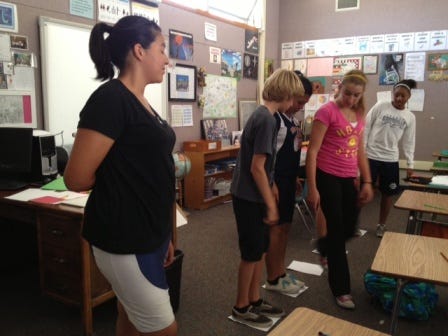I call it Frog Leap, but you might know this game as Stepping Stones or Traffic Jam. NRICH has a nice interactive version.
The challenge: 3 boys and 3 girls need to switch places in the fewest number of moves. A legal “move” means a person can either step into an adjacent empty space or jump over one person into an empty space. (Two people just swapping spots? Not allowed.)
I placed seven pieces of paper on the floor and had six kids act it out. They were stuck several times, even with plenty of input from the audience.
Once they got the hang of the rules, I gave them small cubes to work on individually. When they thought they had found the minimum number of moves, they wrote it down and called me over—no shouting out answers allowed. If they were right, I challenged them to try it with eight cubes (four on each side).
After about 15 minutes of individual work, I randomly paired them up and asked them to track the moves—specifically, which cube moved to which position.
By now, they knew what was coming: we'd want to figure out the fewest moves for any number of people. Two students discovered the equation after testing it with 12 people (six on each side). We tracked all the moves together and admired the symmetry.
It's no big deal if they don't arrive at the general rule. The process itself is what matters. I want them to experience problem-solving regularly—and they are getting better. They’re persevering.
Meanwhile, in geometry…
We’ve been doing basic constructions by hand. So far, they’ve learned how to copy a segment, copy an angle, and bisect both. Nothing too thrilling yet—but I’m looking for geometric theorems they could construct from scratch. I want them to uncover something exciting.
One of my favorite resources is Math Fun Facts by Professor Francis Su of Harvey Mudd College. I geekishly introduced myself to Dr. Su at a UCLA Math Festival years ago. In my world, he’s a rock star.
Su shares a theorem called Pizza Slices:
Take a pizza and pick any point inside it. Now cut the pizza into 8 slices by cutting through that point at 45-degree angles. Color alternating slices red and green.
Surprising Theorem: The total area of the red slices and the total area of the green slices will always be the same!
And that’s what my geometry students did! They constructed perpendicular chords, then bisected the 90° angles to get 45° slices. My kids called them beach balls.
The proof technically requires calculus and polar coordinates—but that doesn’t mean we can’t know about it and appreciate the fun fact.









